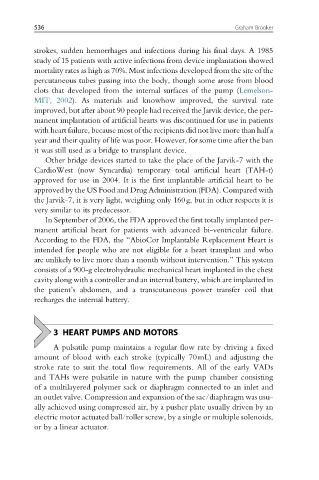Page 542 - Handbook of Biomechatronics
P. 542
536 Graham Brooker
strokes, sudden hemorrhages and infections during his final days. A 1985
study of 15 patients with active infections from device implantation showed
mortality rates as high as 70%. Most infections developed from the site of the
percutaneous tubes passing into the body, though some arose from blood
clots that developed from the internal surfaces of the pump (Lemelson-
MIT, 2002). As materials and knowhow improved, the survival rate
improved, but after about 90 people had received the Jarvik device, the per-
manent implantation of artificial hearts was discontinued for use in patients
with heart failure, because most of the recipients did not live more than half a
year and their quality of life was poor. However, for some time after the ban
it was still used as a bridge to transplant device.
Other bridge devices started to take the place of the Jarvik-7 with the
CardioWest (now Syncardia) temporary total artificial heart (TAH-t)
approved for use in 2004. It is the first implantable artificial heart to be
approved by the US Food and Drug Administration (FDA). Compared with
the Jarvik-7, it is very light, weighing only 160g, but in other respects it is
very similar to its predecessor.
In September of 2006, the FDA approved the first totally implanted per-
manent artificial heart for patients with advanced bi-ventricular failure.
According to the FDA, the “AbioCor Implantable Replacement Heart is
intended for people who are not eligible for a heart transplant and who
are unlikely to live more than a month without intervention.” This system
consists of a 900-g electrohydraulic mechanical heart implanted in the chest
cavity along with a controller and an internal battery, which are implanted in
the patient’s abdomen, and a transcutaneous power transfer coil that
recharges the internal battery.
3 HEART PUMPS AND MOTORS
A pulsatile pump maintains a regular flow rate by driving a fixed
amount of blood with each stroke (typically 70mL) and adjusting the
stroke rate to suit the total flow requirements. All of the early VADs
and TAHs were pulsatile in nature with the pump chamber consisting
of a multilayered polymer sack or diaphragm connected to an inlet and
an outlet valve. Compression and expansion of the sac/diaphragm was usu-
ally achieved using compressed air, by a pusher plate usually driven by an
electric motor actuated ball/roller screw, by a single or multiple solenoids,
or by a linear actuator.

